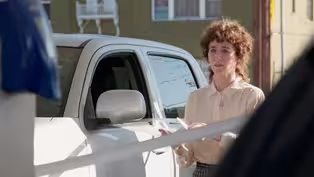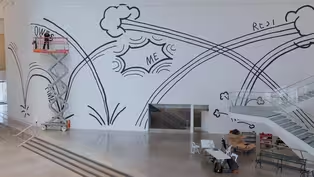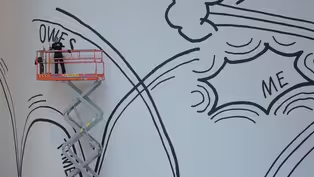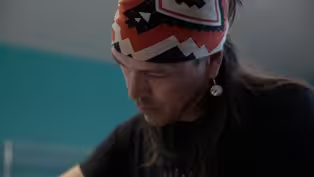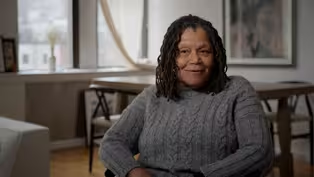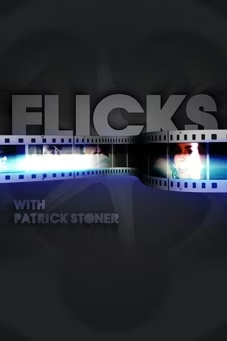
Friends and Strangers
Season 11 Episode 3 | 55m 11sVideo has Closed Captions
Artists look to friends, family and strangers to find emotional connection and community.
Four contemporary artists look inside and outside their immediate circles to find emotional connections and build community. This film showcases playful and poignant sculptures, performances, and more. Includes celebrated filmmaker Miranda July.
Problems playing video? | Closed Captioning Feedback
Problems playing video? | Closed Captioning Feedback

Friends and Strangers
Season 11 Episode 3 | 55m 11sVideo has Closed Captions
Four contemporary artists look inside and outside their immediate circles to find emotional connections and build community. This film showcases playful and poignant sculptures, performances, and more. Includes celebrated filmmaker Miranda July.
Problems playing video? | Closed Captioning Feedback
How to Watch ART21
ART21 is available to stream on pbs.org and the free PBS App, available on iPhone, Apple TV, Android TV, Android smartphones, Amazon Fire TV, Amazon Fire Tablet, Roku, Samsung Smart TV, and Vizio.
Buy Now
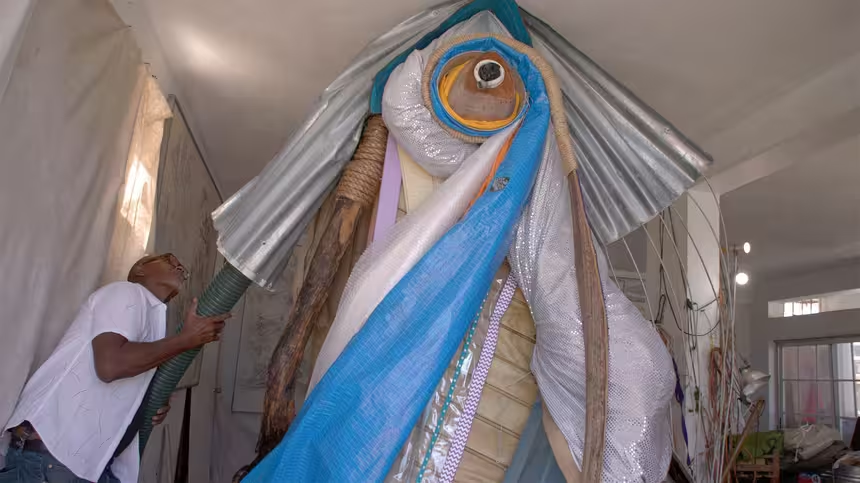
Everyday Icons
Learn more about the artists featured in "Everyday Icons," see discussion questions, a glossary, and more.Providing Support for PBS.org
Learn Moreabout PBS online sponsorship♪ethereal ambient music♪ [door locks] [heels clacking] [loud traffic sounds] ♪elegant orchestral music♪ [Miranda VO] Risk, in general, for me, is really such a comfort zone.
I was the kind of kid who was just like, "Dare me to do something."
I loved the high of that.
♪♪♪ I'm remembering when I was... maybe, like, seven or something, playing at the park, and there was-- you know those really intense basketball games with men playing, and they're just shouting and like, "I'm open!
I'm open!"
You know, like, [chuckling] um... And my friends dared me... to join the game.
[Miranda] Do you mind holding that for a sec?
You can let go whenever you need to let go.
Thank you.
[Miranda VO] And I just jumped right in, and just was like, "I'm open!
I'm open!"
You know, just, like, doing the [chuckling] stuff I saw them doing, and I was, like, floating on air, you know, because I'd done it and I'd survived.
[Miranda] Do you mind just holding this?
You can let go whenever you need to let go.
[Miranda VO] I guess I learned, you know, if you're not afraid -- and why should you really be afraid?
-- then it's like you can fly; you have this superpower.
♪curious electronic music♪ Now, I usually say I'm a writer, filmmaker, and artist.
So, within that, I perform, and I work in these different mediums.
♪♪♪ Some things are hidden for a reason, and if you see them, you'll be changed forever, but I wanted to be changed forever.
[Miranda VO] It feels like there's a million subgenres of all those things.
Like, "filmmaker" -- you know, that, to me, includes feature films... [Miranda] And, cut!
And things you might make really quickly and in an afternoon.
You know, so I'm not really a purist.
♪lush ethereal music♪ You know, I started so young; I started when I was 16, writing and directing my first play.
[footsteps] I had started a correspondence with a man in prison.
There used to be lists of prison penpals in the back of magazines, and I really just chose him at random.
It wasn't romantic because I was, thank God, like, a hardcore feminist, but it was very intimate once that boundary was set.
"Dear friend, this is legal paper.
I wish it was the opposite.
How has your day been so far?
You make me wish we could meet.
Perhaps we can someday."
[Miranda VO] I think he and I were in it for similar reasons in that we loved the attention.
What teenage girl doesn't love... Like, literally, I was the only person -- like, free person -- in his life.
Like, he hadn't gotten a letter in 12 years.
And, like, I became alienated from my friends and high school 'cause I couldn't get this across.
And so I wrote a play.
[man VO] You see, you're making me remember.
But I'm not remembering who I was, I'm remembering who I wanted to be, [whispering] and there's a difference.
I shouldn't be able to know you as well as I do because I...
I mean, I guess one reason I do these projects with people who are so far out of my world is that...
I'm thrown out of my own assumptions about how things work or what things mean, even just very basic things, like even friendship.
Like, "Is this a friendship?"
My parents are writers, so from them, I learned how to be intimate with my work.
And I guess my great hope was that, through my work, I could have intimacy with other people.
Based on what I saw growing up, I wasn't sure how else to connect.
I don't know, the idea of the... you know, the... the found family or the... friend that kind of saves you, like, I... those are sometimes in my work, and it's-- you know, I know it's a kind of common theme, but I can't-- you know, it... [chuckling] never gets old!
[panting] How about this, right?
You think that was the big one?
-I don't think that-- -It was.
That was it.
[laughs] Thank you.
[typing] I dropped out of college, and did want to make movies, and was surrounded by women in bands, and, you know, we started a recording studio in our basement, and, you know, there was very much the sense that, like, you could just figure it out yourself.
So I started this thing first called "Big Miss Moviola," and then Moviola tried to sue me.
Welcome to Big Miss Moviola.
My name is Miranda July, and I'll be your host!
[Miranda VO] The premise was, if you send me your movie, I'll put it on a VHS tape with nine other movies made by nine -other women... -Hi, Vanessa!
[Miranda VO] And send the tape back to you, so we can all see each other's work.
I was providing a service that I needed in order to conceive of myself as a filmmaker, and I did that for 10 years.
I did it until I made 'Me and You and Everyone We Know.'
What are you doing in my car?
[laughs] I don't know you, and you certainly don't know anything about me.
I mean, what if I'm a killer of children?
[chuckling] Yeah, well, that would put a damper on things, wouldn't it?
I remember, actually, after that movie came out, and I remember performing and realizing, like, "They just want to see the girl from that movie."
That actually was, like, a bit of a crisis at first.
And that was actually the point when I started... making pieces that asked a lot of the audience.
[Miranda] When I signal you, if you could just walk towards me very, very slowly.
I noticed her immediately when I walked out on stage that first night.
[laughter] She seemed to radiate light.
♪tender piano playing♪ I've been in two relationships with women before, but... they were more...butch.
[laughter] [Miranda VO] So right now, I'm finishing a book, a kind of long novel... about the second half of a woman's life.
And it's a romance.
There's also dance in my book.
[Miranda] So, this is my novel.
[chuckling] No one's supposed to see this ever, but, um, so don't maybe get too close but... Or it's fine, whatever, who cares?
This is the first half of it.
This is the second half.
When I can't write anymore -- like it's diminishing returns -- then I come to this rack.
It's, like, [chuckling] costumes to dance in?
Or... just to make things in if I want to become aware of my body in a different way.
And then I'd be like, "Well, this was a costume, but-- but who is this," you know?
♪cool percussive music playing♪ And I started actually buying things that make no sense in real life but are great for this sort of thing.
Like, what is... what is this?
♪chipper triangle music♪ [Miranda VO] For me, it's always about energy and excitement and mystery.
And one way it exists is in these mediums; like, simply working in a form with materials you haven't used before is novelty and mystery, and in a quite physical sense, and sometimes in a collaborative sense.
[typing] So, day one of the pandemic, the phone rings, and it's an unfamiliar number, and I answer it, and it's clearly, like, a solicitor.
[dogs barking] Miranda's phone number was assigned to me, but she wasn't a typical customer that will immediately hang up the phone or drop the call.
Maybe I'd somehow ended up on a list for, like, self-published authors, which I'm not.
And so I answered all their questions, and then I said, "Can I ask you some questions?"
Where they were -- they were in the Philippines -- how old they were -- 27.
I couldn't tell what gender they were; they were a trans woman.
[Jay VO] Here in the Philippines, most of the religion is Roman Catholic.
It's very hard for you to be accepted, to belong in the community.
So I started to share my background, and she thought of a project that we can collaborate.
This is the edition -- the limited edition -- that I made out of the project with Jay.
She said that she's gonna be sending me assignment, and then I'm going to respond it in pictures.
This is the first assignment where Miranda asked me to... bow to something that is also important to me, which is money and a bed, because I love to sleep.
So, in this picture, this is where all my suffering happens.
The best feeling is when, you know, you throw down a challenge, and then the person comes back with something much bolder.
I mean, that is what really makes it a collaboration, and that happened so regularly with Jay.
♪calm ethereal music♪ [Jay VO] This is me.
So, sharing that to Miranda was really kind of risky, but at the same time happy because I was able to express everything; like, every pain, every truth that happened to my life is all in this project.
I mean, I'm full of my own... trust, abandonment issues, like, all kinds of things that... make it hard to get close to people, so it's a real miracle when something like that connection can happen.
It becomes very beautiful and emotional and light, which is so... so incredible because it's not very light inside me.
[chuckles] ♪♪♪ I think that's part of the risk thing is, like... literally anything is possible in the moment.
♪♪♪ It's kind of like being in a dream or something.
♪♪♪ But a shared dream, not a lonely, you know, in-my-head dream.
♪♪♪ And the reward of working this way is creative freedom on every level.
♪♪♪ [paper sliding] [interpreter VO] I've just been noticing that my life is just one big echo.
♪sparse ethereal music♪ Or, rather, maybe just small echoes that become one big echo, and that's something that's been a part of my life since I was born.
And it has to deal with repetition... ♪♪♪ patterns... something that constantly comes up.
When I work with interpreters, I experience repetition.
Like, whatever I sign, Beth repeats; she's echoing me.
And sign language is full of echoes.
You can use one hand shape, and echo that -- repeat that -- and it just changes the entire sign or the entire word based on where you put it on your body.
♪♪♪ The shape of the sign for "future" -- which is two semicircles away from your face, that's the sign for "future" -- it has a line that you can follow, so I drew that line.
And it's an echo in and of itself.
♪♪♪ And so since it's my ideas, it's my work that's being presented, and a lot of it does have to do with repetition and a lot of it is full of echoes, I think that is why I want to be as clear as possible.
[chuckles] ♪pulsating ethereal music♪ [interpreter] I'm DJ Kurs of Deaf West Theatre.
At Deaf West Theatre, we bridge deaf and hearing worlds through theater.
We're advancing visibility and representation.
But I'm jealous of Christine Sun Kim, because she does the same thing... but on her own; she can draw a pie chart on paper and have a similar impact.
Please welcome artist Christine Sun Kim.
[applause] So this tweet here that says, "I can 100 percent promise that you learning sign language is easier than a deaf person learning to hear" is a tweet from a deaf writer, and I think that this framing... is it.
[chuckles] This is how I want you to think about who I am.
This is my deaf identity, and this is where I'm coming from.
♪sparse piano music♪ People love to always ask why I don't read lips, so this is a question I've gotten over and over again.
♪♪♪ I love the use of infographics.
It's this idea, shown visually, that can be communicated without barriers; it can cross languages, it can cross cultures.
So this is the same old [bleep] hearing people say to me.
And as you can see, this is equally distributed because people say a lot of [bleep] to me.
[laughter] ♪ethereal synth music♪ [interpreter] They look so good!
♪♪♪ -[man] Cute!
-[interpreter] [laughs] Can you lift yours up more, just a smidgen?
Yes.
Okay, that's-- that's what we want.
-That one up.
-[man] This might be low.
[interpreter] She hasn't mentioned yours.
[man] Okay.
[interpreter VO] I am very comfortable with collaboration.
[interpreter] I think that looks good.
[interpreter VO] I usually work with people, whether that's interpreters that I'm working with or people who are speaking on my behalf; I'm used to that.
♪♪♪ I collaborate with my partner, Tom Mader, a lot, and this has been really nice because I've been able to kind of increase who I collaborate with.
♪♪♪ So, we've all grown as artists and lecturers and performers, so let's not do that, but it's still very easy to find online... [interpreter VO] Motherhood has really impacted my practice.
It's impacted the way I envision and the way I approach art.
♪♪♪ I allow my child to be a part of the process at times.
Sometimes we collaborate on a project.
♪♪♪ Often, I work with musical notation.
I've really thought about the emptiness of the staff lines.
It's not about the notes, necessarily, but it's about the foundation that's being laid.
And I decided to incorporate our family.
I've done one, Tom has done one, and Roux has done one.
When I sat down with Roux and I explained the work, she created this drawing, and then she did another one with notes on it.
And I asked her what it was, and she said to me it was a song about family.
[laughter] I've lived in Berlin now for almost 10 years.
As an artist, I'm having a great life there, because I feel like there's so much less pressure.
♪bubbly synth music♪ What I've noticed is that being a parent doesn't have a dent or an impact on my bank account almost at all.
Daycare is free.
Everything in the city is affordable, [chuckles] especially compared to a place like New York or Los Angeles.
And I also have space to create work.
♪♪♪ So, with all of that, I've just found myself recognizing more and more the benefits of a government that supports their citizens -- like, actually supports their people.
People in Germany aren't in debt.
But here in the US, I see friends living here who have more than one job just to make ends meet, and I realize that I'm angry about debt, I'm angry that people are living like this because I'm...not.
I think about my family, my friends, my future, and I'm worried.
[indistinct chatter] I was so happy to hear from you.
Of course I had to call.
And I think all my friends are coming in next week to see your work.
[interpreter VO] A perk of being a member of the deaf community is that you have this shared culture, this shared language.
And so people like to stay there.
They don't want to be oppressed in the way that they are in the hearing community.
But you kind of get trapped.
Sometimes you get stuck in that echo, and I was there for a while.
But then, I became an artist, and I had to go into the hearing world.
♪uplifting synth music♪ I'm always a little bit jealous of artists who have the privilege to be misunderstood.
For me, I automatically feel like I need to explain what things mean.
I have to say, "No, it's not this, it's that."
And I think that stems from a place of how misunderstandings can affect my rights -- all these little things in my daily life, as well as navigating access, education, entertainment, family.
Growing up, I loved art, but I didn't really take classes 'cause there weren't interpreters available.
♪tender music♪ I remember when I was in high school, there was a sculpture class that I wanted to take that I thought was perfect; I wanted to work with my hands.
They said no.
Then, as an undergrad majoring in graphic design, they had a night class that I wanted to take.
They said no.
So it was interesting; at that time, I kept getting told no.
And then when I grew up and moved to New York, it was super crowded, and there was hearing people everywhere, which wasn't my experience growing up in California.
And so I had to figure out how to constantly communicate with these hearing people.
And people were just in my face, and I was in people's faces.
Because of that, I just had less fear around it.
♪uplifting music♪ And what I've realized is that New York gave me the skills to navigate through the world fearlessly.
[mechanical whirring] When Hitomi, the curator here at Queens Museum, reached out to me and we were corresponding back and forth, I thought, "How could I come up with an idea without actually physically visiting the Queens Museum?"
[indistinct chatter] And in her correspondence, she mentioned that Queens was the epicenter of COVID for a while, and that really struck me and got me thinking.
[honking] [siren] I thought about rest.
I'm also seeing people being overworked during the pandemic, without maybe having health insurance.
♪soft pensive music♪ Lately, I've been into motion lines.
♪♪♪ You can find those in comic strips or comic books.
And I thought they were a perfect reflection of sign language, and how it carries a lot of weight and emotion.
For example, the sign for time: I tap my wrist with my index finger.
I looked at a bunch of different signs that come into contact with the body, and I came up with a one-line poem to fit the current climate and what was happening in this area.
♪♪♪ "Time owes me rest again."
[woman] Yeah, maybe you can shave a little bit.
Yeah, bottom, bottom part.
[interpreter VO] This experience made me think I can work with such a large scale; I thought a lot about that.
And it felt right that maybe this is the best way where we can shove or force our deafness or our existence or our deaf voice, and do that in their everyday lives, in their everyday space.
♪tender ethereal music♪ And it happened that the Manchester International Festival reached out to me wanting to work together, saying that I could show any work I wanted.
And I was like, "All right, let me aim for the biggest thing I can do."
I said, "Let's caption the city."
♪♪♪ I want people to see captions, to think about why they're there, to think about who might want them.
"Oh, yeah!
Deaf people."
My favorite one is this 'cause I wanted it all, I wanted more.
I was like, "Let's caption the sky and get a plane."
♪♪♪ And doing all that work has given me the realization that scale equals visibility, and... that has the ability to shape social norms.
I want deaf lives to be in your mind, and be part of what we consider acceptable, what's normal.
♪uplifting music♪ If you don't see us, we have no place to be, and I think that's why I've gotten into scale, and also, I'm just greedy, too.
[laughter] [bells jingling] [bells jingling] [Cannupa VO] I think we all struggle with what it means to belong to a place.
As an Indigenous person in North America, there are complex identities that are at play.
I am a citizen of the Mandan, Hidatsa, and Arikara tribes, so I was born in Standing Rock Reservation, right on the Missouri River.
I think in its most honest form, I'm river people, and I'm living up here in the mountains in New Mexico.
So I feel... a little displaced.
After my family moved us off of the reservation, it felt as though my existence in both of these worlds was in, like, a liminal space between the two.
[man] Okay, Cannupa, you ready?
[Cannupa] Yeah, hold on.
[indistinct chatter] [Cannupa VO] So I exist in the world between places.
What I'm trying to do is remove the idea of art as an object, and think of art as a process.
Something in action, something living.
-[bells jingling] -♪sparse curious synths♪ I'm building things.
I'm building things that aren't these objects but conduits to share information from culture to culture.
♪♪♪ There's a tendency to perpetuate this romantic, historical narrative of Native people, which is, "This is primitive, this is ancient, this is not present."
And so I started a whole series of projects that were called -- and it's kind of an ongoing set of ideas -- but it's called Future Ancestral Technology.
It's science fiction, it's speculative fiction.
It's imagining what and how our culture shifts and changes into the future.
♪airy ethereal music♪ And if it's hard to express what it means to be Indigenous today, what does it look like if I bypass today and consider what it means to be in a distant future?
♪♪♪ So, like, all of the stuff that we're using right now is gonna be around for a while, sitting in landfills.
And rather than recycling it and turning it into new products, I'm like, "What do we do if we just transform this material?"
[Cannupa] These are, like, hockey gloves.
This is an old crochet blanket.
I maintain a hunter-gatherer practice in the 21st century, but the fields that I navigate are different.
All of the wool that I get secondhand, it's leftover.
So, there's very few things in the making of any of this work that is dependent on firsthand manufacturing.
Any time I go to a thrift store, if they've got an Afghan and I like its kind of color story, I will dive in, and...
It's like navigating the detritus of America.
And it's important to tell these stories for future generations because a lot of Indigenous cosmology is based on sustainability.
Like, "You are an extension of the land, you belong to the land."
Could I imagine a future where we all understood that collectively?
A protest in North Dakota against a major oil pipeline continues to grow.
Over 100 Native-American tribes have joined the fight against the project, saying that it threatens one tribe's water supply and its sacred land.
[Cannupa VO] In Standing Rock, it was described as "protest," but the reality of that situation was... everybody who came there was standing to protect water more than against oil.
Seeing a riot police line, the gear that they wear is just completely dehumanizing.
And so, I was inspired by civil unrest that unfolded in Ukraine, where people were bringing mirrors to the front line so that the police could see themselves.
I went to a hardware store, and designed and made these mirrored shields in the parking lot, and made a video to show how to make them.
♪energetic inspiring music♪ The main thing is that it's an empathetic response to violence.
♪♪♪ At the time that we were bringing, like, 500 shields into Standing Rock, the police and these private security forces, they were confiscating anything that could be considered a weapon.
And we decided that the best way to hide these pieces was to utilize my privilege as an artist.
♪♪♪ And we were like, "No, these aren't shields.
It's just an art piece."
[footsteps in gravel] Mm.
There were antelope horns on this piece, and I think I locked moisture in, and they exploded.
The unfortunate thing is... they fell on some of my sons' work.
My oldest boy, 'io, made this little guy.
He says it's a monkey.
And my youngest, we've got this...
I don't know, it looks like a Texas toast hamburger with a face on it?
And here's my spider head.
♪sparse ethereal music♪ Oh, here's the fam.
Hey, boys!
[Ginger VO] During the pandemic, everything shut down.
Before that, Cannupa was traveling, like, 80, 90 percent of the time, and it wasn't sustainable.
Thanks, guys!
I don't know where my art practice is different than my life, and they're a part of my life.
Hey, if you guys want to make something alongside me, you can go grab some clay out of my studio.
[Ginger VO] This past year, we've been traveling with our whole family.
[Cannupa VO] We homeschool our children -- had been homeschooling them even prior to the pandemic.
Bringing them along on these trips is an important part of their education.
And we thought that doing that would create a healthier bond with all of us.
[Cannupa] What do they say?
"You've got to get your own house in order... [chuckling] before you start telling somebody else to clean up."
♪♪♪ I have a hard time with the title of "artist," you know?
Like, that's what you do.
That's who you are; you're an artist.
You are what you do, right?
So I'm an artist, because I make art.
And I'm like, "Do I, though?"
I always like to think of myself as an engineer, and I talk about bridge building, you know, as an artist, and the gap that I'm trying to span is the gap between all of the different communities and cultures that I interact with.
[Cannupa] So, we're just rolling these cubes into spheres, and once they're spheres, you'll take one of these little skewer sticks and pierce the clay into a bead.
The grasslands where I'm from are dependent on buffalo, and so the 20,000 that are living wild today, I thought it would be a great gesture that we make a bead to represent each of them.
Even just rolling that clay in your palm, there is no two that will be the same, and the idea is us in relationship with one another.
♪pensive ethereal music♪ [Cannupa VO] So the bison bead project is part of this ongoing series called 'Counting Coup.'
And the intentions were basically just trying to rehumanize data, you know?
The first work in that series is called 'Every One,' and the number of beads represents missing and murdered Indigenous relatives.
♪♪♪ [bells jingling] Indian and American history aren't told in an honest format, they're told as myth.
It is the myth of the individual who had to raise themselves up out of nothing.
I like those shoulder pads with it.
All right, you got that pod?
[Ginger] Yeah, I got it.
I think it comes from, you know, a group of men who decided that they were no longer gonna be a part of England; you know, they were going to remove their self from their ancestral place.
And the violence that that displacement inflicts on everybody else around it?
You have to have this myth in place that justifies the brutality of individualism.
-Papa.
-[Cannupa] Yeah?
Do this.
[bells jingling] [Cannupa VO] But it's just a myth and it's just a story.
Okay, that's great.
When we do it again, spend a little more time going back-- like, featuring your back.
[sighs] Okay.
There is an entire ecosystem around successful artists.
They're getting support from their partners, from their parents, from their friends.
Thank you, Ginger!
♪curious ethereal music♪ I want to be artist/game designer... /YouTuber.
All I wanna do when I grow up is figure out... what I wanna do when I grow up.
I believe that when my children are my age, the definition and the exploration of what art is, hopefully, is so much broader.
It's like, "Can you do whatever you do beautifully in your life?
Can you make your life beautiful?"
Today, we celebrate individuals, we celebrate genius.
But... it's not sustainable.
♪tender synth music♪ [Ginger] Careful, buddy.
[Cannupa VO] We are dependent not just on each other, but our relationships to the environment and other species.
♪♪♪ The truth of our daily lived life is one of integration, is one of integrity.
That's how we survive the future.
[soil tumbling into wheelbarrow] [Linda VO] I came out of the womb knowing I wanted to be an artist, so that was always there.
And I started very young -- when I was around five or six.
You know, I'd have to tell a story about when I was, like, seven or eight.
I asked my father for a nickel to buy a popsicle, and his response was...
"No."
[laughing] I was like, "No?!"
So then I said, "How do I make a nickel?"
And I decided that the way to make a nickel was to get all the kids on the block... we could make a musical, not charge the parents to come, but make lemonade and sell the lemonade at nickel a cup.
And we were able to make enough nickels selling lemonade at our musicals so that we never had to ask for a nickel from a parent or anybody else for two summers.
[interviewer laughs] I have always believed in that.
And what did I have?
What did we have?
I didn't have any money.
I've never operated... Life is not dictated by how much money you have if you realize how many other resources that are much more valuable than that, like our imaginations and creativity -- much more valuable than that.
[laughing] And I learned that at the age of seven or eight.
♪chill funky music♪ I came to New York in '72, and I came to New York with two children and didn't know a soul, to go to grad school at City College.
So that's how I got here.
♪♪♪ I was working at The Studio Museum as Director of Education, and artists would come and get in conversations and stay all day, and it was wonderful.
But inevitably, at the end of every day, the conversation shifted to, "They won't let us.
They won't let us."
And the "they" was the art market, and they wouldn't let artists that were African American or other artists of color be exhibited.
So, my response to that was, you know, "[bleep] it.
Let's just do it ourselves."
♪upbeat funky music♪ And I heard about this gallery, and so I went down to the opening, and it was like Heaven.
[Linda VO] I mean, people were in the lobby of the elevators, they're down the stairwells, they're outside on the street trying to get into the gallery.
[Janet VO] It was just vibrant!
It was vibrant, it was alive, there were ideas, there were things I'd never seen before, there were things I had seen or could imagine making.
In the sense of ownership, in terms of doing this, even if you weren't showing there, you were creating a space that you could go to and see artwork of friends, of colleagues, and so it was a place of belonging.
♪cool jazzy music♪ And I was really interested in artists in LA; I was really interested in David Hammons and Senga Nengudi and Houston Conwill, and a host of people.
♪♪♪ At that time, there was a debate between Black artists who were working figuratively, and those who were working in an abstract or conceptual way.
And those many artists who were working figuratively believed you weren't a Black artist if you weren't working figuratively.
That came to a head at JAM, and it was David Hammons' first show.
Artists were like, "What is this mofo doing?"
And so everybody wanted to see it.
[Randy VO] David Hammons working with hair.
So much of the Black experience was about hair.
And so these experiences that you live, and how do you make those experiences into something that is visibly tangible?
And I think Linda was able to identify that very quickly, and say, "That's important."
♪♪♪ It started out for artists of color -- Black artists, mostly -- but then she started seeing work by white artists, women, and they were doing things that were just as experimental, just as nuts.
If JAM had only shown Black artists, we would've been replicating the racism and the segregation [chuckles] that the other institutions were doing.
Why would I do that?
So, in those early days, Wendy Ehlers showed work, and she made work with lint -- dryer lint.
I believe she had four or five kids, and she washed a lot of clothes.
♪upbeat funky music♪ So when we started JAM, I had enough money to ensure that we all had a buttered roll.
And people hung out at the gallery and worked; [chuckling] no one got paid.
So there was a buttered roll for anybody who was there.
[Maren VO] It was really hard.
It's hard to live in New York.
Linda struggled.
I don't know how many collectors she had, but I'm assuming there weren't a lot of collectors in the beginning for Black art.
[Linda VO] The primary objective was not selling the work; the primary objective was artists making the most amazing work they could make.
[staccato breaths] So the opportunities... the openness-- when I say "opportunities," just like, "What do you wanna do?
Do it.
What do you wanna do?
Do it," was just how we operated.
[woman] That looks very nice.
[man] Nice, it's nice.
♪energetic funky music♪ [Linda VO] You can say, "Well, how can you not worry about money?"
I never had money, and, you know, you can live without money.
There are other resources you can use.
And I discovered, when I started JAM, that one of the resources I could generate and use was debt.
♪quirky music♪ There were [laughing] always bills and past-due notices and "We're gonna take you to court."
Astor Wines & Liquor -- [scoffs] "Linda, you owe us how much?"
And I'd go, "I know, but we're having this opening, and we have to have some wine."
[chuckling] You know?
And he was like, "Ugh, all right, come down and get some."
When you're just that committed and passionate about something you believe in, other people believe.
♪airy ethereal music♪ [Ishmael VO] I think JAM acted as a catalyst.
I mean, the art, of course, was important, but it was also bringing an art community together -- bringing disparate people, disparate visions together.
And I think that's sort of her role in life kind of -- or her role in art -- is to create situations, and then, sort of like the mad scientist, watching what happens.
♪♪♪ [Maren VO] It was a wild and crazy, seat-of-your pants... You know, it was a conceptual idea that somebody made... visible.
♪♪♪ [sighs] Somewhere-- how about... somewhere in there?
[Maren VO] I made the decision to be an artist and I did it, and that's it.
I think this way.
It sure took me a long time to have a solo show or, you know, ongoing representation.
That began two shows ago.
♪♪♪ So, what, I was 70 already?
Okay, great.
Perfect.
[Maren VO] It was through Linda that I got my foot in the door.
And it's through her that my foot stays there.
[laughs] [Maren] I think it's looking nice.
[Linda] Yeah.
[Maren] So I'm happy about that.
[Linda] Yeah!
-Yeah, and-- -Yay!
And I don't think snow and rain or anything-- it's galvanized.
-It's beautiful!
-Yeah.
It's already beautiful.
[Maren VO] You felt her support, you know?
And you felt it was not just you against the world, it was you and her against the world.
[Linda] This is really... how I kind of imagined it.
-[Maren] Oh, good!
-[Linda] Yeah.
No, this is fantastic!
-[Maren] Okay, great!
-Great!
And I'm glad you're warm... -almost.
-Uh, well... -[Linda laughs] -Yeah.
Tighten up, tighten up!
Art is... evidence of life.
The art is the life that you live.
I mean, you could be an artist and never make work.
♪♪♪ [Linda VO] It never really was about objects, it never was about commerce, it was about creativity, and frankly, JAM was an artwork for me.
-[Linda] Hi.
-[woman] How are you?
[Linda] I'm good!
I was trying to decide if I was gonna squat.
[Linda VO] First of all, I believe all humans are artists.
[Linda] But I am not a great squatter, so I think I might keep shoveling.
[laughs] We are the only species -- humans [laughs] -- are the only species that we know of to date that have the ability to imagine and transform what we imagine in our heads -- the visions we see -- into something tangible that others can experience.
[Maren VO] She has this project EATS now, which is feeding people.
So it's an offshoot of the whole gallery idea.
♪tender music♪ Well, my mission here is to learn how to grow in feeding my elders, my age, my peers, and our children more healthier foods.
This is all been here since May.
[woman] Oh, wow.
[Linda VO] We are currently operating six farms.
We should all be able to grow our own food where we live.
Even if we live on concrete, we should be able to pull that off.
So anyway, that's my art now, is Project EATS and feeding people.
♪soft uplifting music♪ When I was approached about doing a MoMA show, I was reticent and, you know, like, "Mm, I don't-- that's not where I'm at."
But as I thought about JAM and MoMA being four blocks away from one another and MoMA just totally ignoring Just Above Midtown, I got this notion in my head about, "Is it even possible for JAM to be JAM at MoMA?"
And I like a challenge.
I love a challenge.
♪♪♪ [Randy VO] To have a belief in yourself and a belief in your artists, that is so affirming.
I often think of someone sitting in a rocket ship on their way to the moon, and being so confident [laughs] that they're gonna get you there and back.
You know, and I think Just Above Midtown had that type of confidence -- that "We will get you there and back."
♪♪♪ [Linda VO] That JAM could be JAM at MoMA?
Shoo... Yeah, that was-- like I said, I could really, really, really look up and see the elders sitting in the rafters and say, "Y'all did it.
Y'all did it.
We are here.
We're in the infrastructure of this mofo now."
And I like that, because we should be, we should have been, and... and we are.
♪ethereal ambient music♪
Artist Miranda July Performs At a Gas Station
Video has Closed Captions
Clip: S11 Ep3 | 1m 30s | Artist Miranda July performs at a gas station in Los Angeles, California. (1m 30s)
Christine Sun Kim Explains Her Site-Responsive Project
Video has Closed Captions
Clip: S11 Ep3 | 1m 14s | A muralist paints Christine Sun Kim’s work “Time Owes Me Rest Again” at the Queens Museum. (1m 14s)
Video has Closed Captions
Preview: S11 Ep3 | 30s | Artists look to friends, family and strangers to find emotional connection and community. (30s)
"Future Ancestral Technologies"
Video has Closed Captions
Clip: S11 Ep3 | 1m 17s | Artist Cannupa Hanska Luger talks about his series, “Future Ancestral Technologies.” (1m 17s)
The Origin Story of the Art Gallery "Just Above Midtown"
Video has Closed Captions
Clip: S11 Ep3 | 1m 17s | Artist Linda Goode Bryant shares the origin story of the art gallery, Just Above Midtown. (1m 17s)
Providing Support for PBS.org
Learn Moreabout PBS online sponsorshipSupport for PBS provided by:
